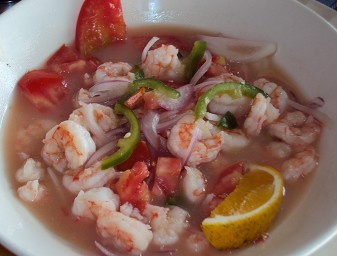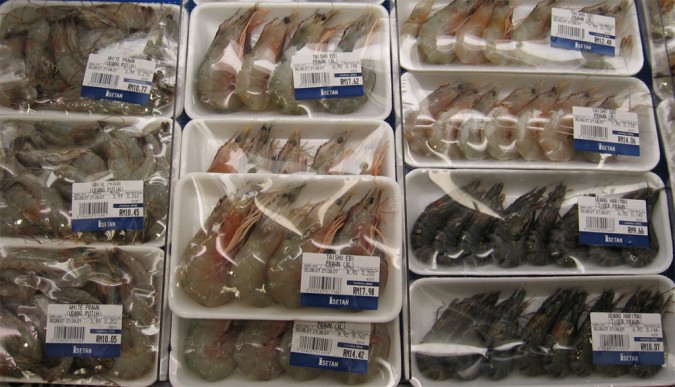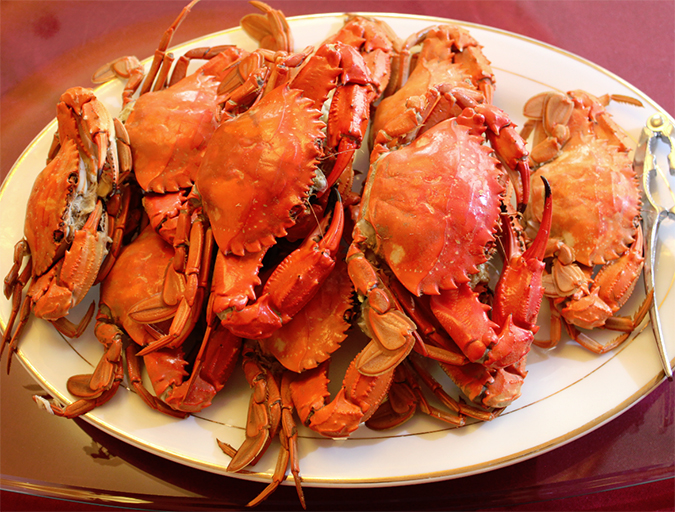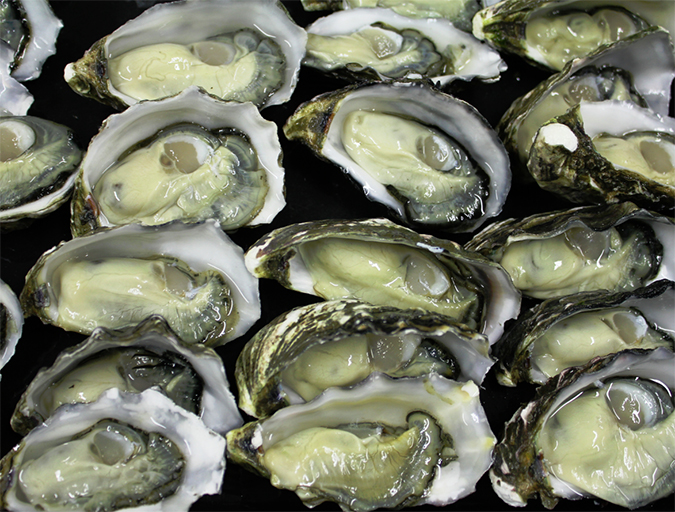Despite an unfair reputation, most people can eat shrimp as part of a well-balanced diet

Many people, including health-conscious consumers, are concerned about the cholesterol content of foods such as meat, eggs and dairy products. In the case of shrimp, the cholesterol story is different because a number of research studies have demonstrated that the high percentage of “good fats” in shrimp reduce the impact of cholesterol, and that a majority of people can eat shrimp as part of a balanced diet.
What is cholesterol?
According to the American Heart Association, cholesterol is a waxy substance that originates from one’s body and from food. We make all the cholesterol we need, especially in our livers. Dietary cholesterol comes from animal sources, such as meat, poultry and full-fat dairy products. Our livers produce more cholesterol when you eat a diet high in saturated and trans fats. Excess cholesterol can form plaque in artery walls, making it harder for your heart to pump and circulate blood, and plaque can cause blood clots, which can cause a stroke. If it blocks an artery that feeds the heart, it causes a heart attack. There are two types of cholesterol: “good” and “bad.” Too much of one type – or not enough of another – can put you at risk for heart attack, coronary heart disease or stroke.
‘Good’ and ‘bad’ cholesterol
Cholesterol travels through the bloodstream in two kinds of lipoproteins that carry cholesterol throughout your body: low-density lipoproteins (LDL) and high-density lipoproteins (HDL), which have been referred to as “plump little fat and protein packages.” LDL is known as “bad cholesterol” because it leads to a buildup of cholesterol in your arteries and may promote the production of artery-blocking plaques that can result in a heart attack. HDL is called “good cholesterol” because it returns cholesterol back to the liver for reprocessing or excretion, which reduces cholesterol levels in the bloodstream.
High blood cholesterol is a condition where a person has too much cholesterol in his/her blood, and can have a greater chance of getting coronary heart disease, also called coronary artery disease. The higher the level of LDL cholesterol in your blood, the greater your chance is of getting heart disease, and conversely, the higher the level of HDL cholesterol in the blood, the lower the chance is of getting heart disease. A positive ratio between two types of cholesterol, low-density lipoprotein (LDL) and high-density lipoprotein (HDL) reduces susceptibility to heart disease, and is an important number to monitor.
Shrimp and dietary cholesterol
Cholesterol from food has a negative impact only if it is absorbed, and saturated fat seems to assist absorption. Eating food with a highly saturated fat content raises the LDL cholesterol. Most high cholesterol foods (such as meat, eggs and dairy products) are also high in saturated fat and increase LDL. Shrimp have a relatively high level of cholesterol but have essentially no saturated fat (slightly over 1 gram per serving, compared to beef that can have 10 to 20 grams). And the cholesterol in shrimp is harder to absorb than that from other high fat foods, although the reasons are not known.
At the very least, it is fair enough to say that the cholesterol in shrimp and other seafood is unlikely to damage the arteries provided the seafood is not battered or crumbed and cooked in saturated fat.
In the past, scientists could not differentiate the different sterols and measured them all as “cholesterol.” This is why the amount of cholesterol in shrimp and other shellfish was reported as very high. The cholesterol in shrimp is approximately 130 mg per 3 ounces of raw shrimp, or about 12 large shrimp, and with only 2 grams of fat. The amount of cholesterol in a comparable portion of regular ground beef is about 110 mg, with approximately 20 grams of fat. And shrimp have high levels of beneficial highly unsaturated fatty acids, which raise HDL cholesterol levels, so eating shrimp may actually lower blood cholesterol levels.
Dietary cholesterol is not the main cause of high blood cholesterol, per information from several sources including Seafish (www.seafish.org) and the Shellfish Association of Great Britain (www.shellfish.org.uk). The latter two report “Blood cholesterol levels are determined by a number of factors. Genetic factors can affect the absorption of cholesterol, the manufacture of cholesterol or the uptake of cholesterol into body cells. Research has shown that the amount of saturated fat in the diet has a greater effect in raising blood cholesterol than the amount of cholesterol in the diet.”

Many relevant studies
A number of research studies have addressed the relationship between shrimp and cholesterol. A landmark study performed in the mid-1990s by scientists from the Harvard School of Public Health and Rockefeller University in New York (Oliveira et al. Effects of shrimp consumption on plasma lipoproteins. Am. J. Clin. Nutr. November 1996 vol. 64 no. 5 712-717) concluded that eating steamed shrimp raised blood cholesterol levels when compared with a low cholesterol diet. However, the shrimp diet raised levels of HDL (the “good” cholesterol) more than it increased levels of LDL (the “bad” cholesterol), and the resulting HDL to LDL ratio was favorable. A positive ratio between two types of cholesterol — low density lipoprotein (LDL) and high density lipoprotein (HDL) — keeps blood cholesterol levels in check and reduces susceptibility to heart disease. The Rockefeller researchers also determined that study participants on the shrimp diet had significantly lower triglyceride levels than those on either the baseline or the egg diet.
More recently, Drs. John D. Griffin and Alice H. Lichtenstein, in their article “Dietary Cholesterol and Plasma Lipoprotein Profiles: Randomized-Controlled Trials” (Curr. Nutr. Rep. 2013 Dec; 2(4): 274–282), reported that “Early work suggested that dietary cholesterol increases plasma total cholesterol concentrations in humans. Given the relationship between elevated plasma cholesterol concentrations and cardiovascular disease risk dietary guidelines have consistently recommended limiting food sources of cholesterol. Current intakes are approaching recommended levels.
Recently there have been calls to reassess the importance of continuing to recommend limiting dietary cholesterol. Over the past 10 years there have been a limited number of studies addressing this issue. Striking among these studies is the high degree of variability in background diet, subject characteristics and study design. Within the context of current levels of dietary cholesterol intake, the effect on plasma lipids concentrations, with primary interest in LDL-C cholesterol concentrations, is modest and appears to be limited to population subgroups. In these cases, restrictions in dietary cholesterol intake are likely warranted. The biological determinants of inter-individual variability remain a relatively understudied area.”
Benefits of eating shrimp

Information developed by nutritionist Dr. Rosemary Stanton Ph.D., APD — a most well-known “celebrity” nutritionist in Australia — for the Australian Prawn Farmers Association (www.apfa.com.au), report that shrimp are an excellent source of protein, low in saturated fats, a great way to get iron, zinc and Vitamin E, as well as a good source of omega-3 fatty acids.
These valuable fats lower triglyceride levels and have many other benefits for heart health. Shrimp have less fat and therefore contain a lower level of omega 3s than some other seafood (like Atlantic salmon), but the omega 3 content in prawns (average of 120 mg/100g) is well above the minimum 60mg/100g required for an official label of “good source of omega 3 fatty acids.”
Information from The George Mateljan Foundation – a not-for-profit foundation with the mission is to help you eat and cook the healthiest way for optimal health (www.whfoods.com/genpage.php?tname=foodspice&dbid=107) – provides a wealth of information on the numerous benefits of eating shrimp. For example, shrimp is an excellent source of the antioxidant mineral selenium (56 mg per 4 ounces). Recent research has shown that the selenium in shrimp can be well absorbed into the human body (an estimated 80-85 percent for total selenium absorption). Selenium deficiency is a risk factor for heart failure and other forms of cardiovascular disease, type 2 diabetes, compromised cognitive function, and depression.
Another example is Glutathione Peroxidase (GPO), a very important enzyme that cannot function without the mineral selenium; it helps protect a majority of our body systems – like our lungs – from unwanted damage by oxygen-containing molecules. And shrimp can be a distinctive source of the antioxidant and anti-inflammatory carotenoid nutrient astaxanthin (a single 4-ounce serving of shrimp may contain 1-4 mg of astaxanthin. This carotenoid has been shown, in animal studies, to provide antioxidant support to the nervous and musculoskeletal systems, as well as decreased risk of colon cancer and decreased risk of certain problems related to diabetes.

Per The George Mateljan Foundation, a serving of shrimp (steamed, 4 ounces, or around 113 grams) provides a significant portion of the Daily Value or Dietary Reference Intake (DV, DRI) for many valuable nutrients, including protein (52 percent) and omega-3 fatty acids (14 percent); minerals like selenium (102 percent), iodine (31 percent), phosphorus (50 percent), and zinc (17 percent); and vitamins like Vitamin B12 (78 percent), Vitamin B3 (19 percent), Vitamin E (17 percent), Vitamin B6 (16 percent) and Vitamin A (11 percent).
A word of caution: In a small number of people (about 1 in 100) high blood cholesterol can be caused by a genetic condition called Familial Hypercholesterolaemia (FH) or Familial Combined Hyperlipidaemia (FCH). This autosomal dominant disorder is characterized by high cholesterol levels, specifically very high levels of low-density lipoprotein (LDL, “bad cholesterol”) in their blood and early cardiovascular disease. People with this condition often need to pay more attention to their consumption of high cholesterol foods.
Perspectives
A serving of a dozen large shrimp contains 130 mg of cholesterol. This should not be a health concern, because shrimp is a low-fat food with a rich content of highly unsaturated fatty acids, which lead to the formation of high density lipids, commonly known as “good cholesterol.” Consuming shrimp may actually lower blood cholesterol levels. Scientists have concluded that a healthy diet can include shrimp, boiled or broiled. As with most foods, it is better to avoid deep-frying, and to limit the amount of oil, butter, tartar sauce and mayonnaise.
Per Dr. Rosemary Stanton, the Japanese are the world’s greatest consumers of shrimp, and they also have the highest life expectancy, so there may be a connection. “At the very least, it is fair enough to say that the cholesterol in shrimp and other seafood is unlikely to damage the arteries provided the seafood is not battered or crumbed and cooked in saturated fat.”
Authors
-

Darryl E. Jory, Ph.D.
Editor Emeritus
Global Aquaculture Alliance
Portsmouth, NH, USA[103,114,111,46,101,99,110,97,105,108,108,97,101,114,117,116,108,117,99,97,117,113,97,64,121,114,111,106,46,108,121,114,114,97,100]
-

Roy D. Palmer, FAICD
GILLS
2312/80 Clarendon Street
Southbank VIC 3006 Australia
www.seafoodprofessionlas.org
[109,111,99,46,108,105,97,109,103,64,100,121,111,114,114,101,109,108,97,112]
Tagged With
Related Posts

Intelligence
Food is abundant, yet people are starving
While significant numbers of people are undernourished, an increasing number of people are overweight. The divide between recommendations and results is marked, so we must learn more about food production and change our behaviors.

Intelligence
Healthy populations wanted: U.S. guidelines get it right
The 2015 "Dietary Guidelines for Americans" suggest eating at least 8 ounces of seafood per week, and advise pregnant and breastfeeding women to eat 8-12 ounces weekly. It's about time.

Intelligence
Doctors: Place a greater value on seafood consumption
Many important organizations around the world fail to acknowledge the importance of seafood to human health and well-being. There is a disconnect between what we know regarding the benefits of seafood and what is being done to acknowledge these benefits and increase seafood consumption in nutrition.

Intelligence
Can aquaculture help with mineral, vitamin deficiencies?
According to the World Health Organization, 2 billion people are affected by mineral and vitamin deficiencies. Aquaculture producers should review the mineral content of culture waters and in fish diets and whether they can manipulate these two key variables.

